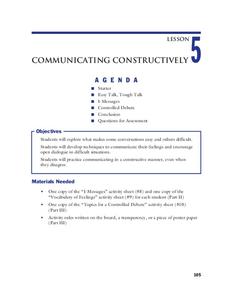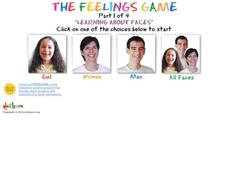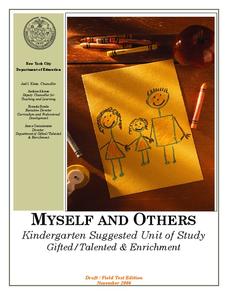Overcoming Obstacles
Communicating Constructively
Some types of verbal communication are just more difficult that others. High schoolers engage in a series of activities that are designed to help teens make difficult conversations easier and more effective.
Do2Learn
Social and Emotions Picture Cards
Social and emotional skills are a difficult task for people with autism to master. Help them become more aware of day-to-day emotions as well as how to express them with this massive set of picture cards.
Do2Learn
Social Play Action Figures
Three activities stem from one hands-on project designed to explore character traits. Scholars create an action figure that reflects their personality to teach others about themselves and role play conversational skills.
Do2Learn
Emotions Color Wheel
Support emotional development with a color wheel featuring a variety of feelings. Each expression comes equipped with an informative pop-up offering a picture, its etymology, a definition, and an example statement.
Do2Learn
Feelings Chart
Some days are better than others. Help autistic learners and other members of your class who have difficulty expressing their emotions with a feelings chart that presents a smiling face, a less smiling face, a neutral face, an unhappy...
Do2Learn
The Feelings Game
Discerning emotions and intent from facial expressions can be difficult for many learners, particular those with autism spectrum disorder. Help class members practice reading faces with an interactive resource that features three...
Keep Your Children Safe
Hurt Tracker Math
Boost emotional intelligence and division skills with a three-question learning exercise featuring two imaginary towns that record when citizens hurt, forgive, or punish one another. Using division, scholars calculate each problem to...
Keep Your Children Safe
Fleeting Happiness
Shed light onto the subject of happiness with a worksheet that focuses on how the emotion—much like other emotions—does not last forever. Scholars read brief passages and answer nine short-answer questions that examine their personal...
Keep Your Children Safe
What Is Happiness
Explore the feeling of happiness with a worksheet created to boost emotional intelligence. Scholars detail what makes them happy then draw a happy face.
Keep Your Children Safe
What Makes Me Afraid
Encourage scholars to be brave about feeling afraid with worksheet designed to enhance emotional intelligence. Learners share what makes them feel afraid then draw a face that appears scared.
Keep Your Children Safe
What is Sadness
Encourage emotional intelligence with a instructional activity examining the feeling of sadness. Scholars answer the question, "What makes you sad?" and draw a what their face looks like when they are sad.
Keep Your Children Safe
What Is Anger
Enhance emotional intelligence with a worksheet that allows scholars to explore the feeling of anger. Learners detail what makes them feel angry and draw an angry face.
International Boys' Schools Coalition
Empathy
Putting yourself in someone else's shoes is a common phrase we hear from time to time, but do children really understand? Explore empathy with elementary schoolers using these activities. Focusing on feelings and emotions, students role...
Talking with Trees
Empathy
Strengthen the skill to empathize with others with a worksheet that challenges scholars to match emotions—including happy, confused, sad—to one's body language.
Museum of Tolerance
Music Evokes Memories and Emotions
Dim the lights, take a deep breath, and press play to explore the emotions and memories that music elicits. Class members begin using relaxation techniques designed to create a positive listening experience. As music plays, learners...
Pearson Longman
Emotions Reading
Explore the many types of feelings and how people express them with a lesson compiled of kid-friendly activities that spark critical thinking, self-reflection, and reinforce language and writing skills. Scholars delve into the variety of...
Project B.A.S.I.C. Child Development Specialist and Child Care Consultation
Better Attitudes and Skills in Children
Little kids often have very big feelings, and need help expressing them. A set of social emotional lessons provide tangible ways for young elementary learners to visualize their emotions, focus on clear communication, and channel their...
National Council for the Social Studies
Analyzing a Product or Political Advertisement
How do advertisements evoke specific thoughts and feelings? Class members find out through the exploration of the Internet, videos, television, magazines, radio, and posters. Learners investigate commercial advertisements, political...
New York City Department of Education
Myself and Others
Self reflection is an important skill to reinforce in our children, and it's especially helpful to help them realize who they are in the context of their environment. A collection of lessons about self image and community encourage...
Council for the Curriculum, Examinations and Assessment
Feelings and Emotions
Eighth graders express their emotions with a set of activities about self reflection and feelings. With a set of emotion cards and a worksheet that details negative thought patterns, the resource empowers young learners to discover and...
Peaceful Solution Character Education
Self-Control Starts With You
How can negative thoughts affect your life? Learn about the ways you think about yourself can define your personality, and how self control can be the answer to higher self esteem.
English is a Piece of Cake
Emotional Intelligence
How would you describe a great leader? Explore the theme of leadership with a unit that focuses on emotional intelligence, and how great leaders have a strong sense of emotional intelligence.
Conflict Resolution Network
Empathy
Children are naturally friendly and communicative, but often have a hard time expressing their emotions in a clear and understandable way. Help them hone their communication skills with a set of activities based on creating empathy,...
Edutopia
Empathy
Teach your learners about support, respect, and listening skills with an activity about empathy. Class members set goals for themselves regarding their peer relationships, and monitor their own progress over a period of time.

























